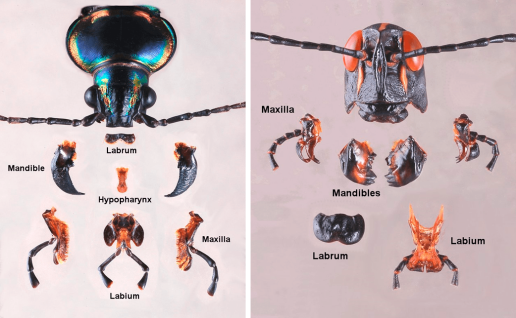Modification of mouth parts
Based on the feeding habit, Mouth can be divided into two parts:
A) Mandibulate: Biting and Chewing type.

B) Haustellate : Piercing and Sucking type.
Haustellate mouthparts can be further classified as follows:
a) Stylet: Stylets are needle-like projections used to penetrate plant and animal tissue.
I. Piercing-sucking: e.g. Mosquito
![]()
II. Rasping-sucking: e.g. Thrips

b) Non-stylet:
I. Siphoning: e.g. Butterflies

II. Sponging: e.g. House fly

III. Chewing-lapping: e.g. Honey Bee

A) MANDIBULATE MOUTH PART
- Mandibulate (Biting and chewing) mouthparts are used for biting and grinding solid foods.
- Examples: Dragonflies and damselflies (order Odonata),Termites (order Isoptera),Adult lacewings (order Neuroptera), beetles (order Coleoptera),Ants (order Hymenoptera), Cockroaches (order Blattaria),Grasshoppers, crickets and katydids (order Orthoptera), Caterpillars (order Lepidoptera). Adult Lepidoptera have siphoning mouthparts.
B) PIERCING-SUCKING MOUTH PARTS
- Piercing-sucking mouthparts are used to penetrate solid tissue and then suck up liquid food.
- Examples: Cicadas, aphids, and other bugs (order Hemiptera), sucking lice (order Phthiraptera), stable flies and mosquitoes (order Diptera).
- Plant feeders like leafhoppers, aphids and scales have the same basic mouth part structure and many inject viruses and other disease-causing organisms into the plant along with their saliva.
C) RASPING AND SUCKING MOUTH PARTS
- Are found in thrips (Thysanoptera).
- The right mandible of thrips is reduced– and in some species completely absent.
- This beak contains the maxillae, hypopharynx and the left mandible; together this structure forms a stylet.
- Thrips use the beak to rasp host tissues and take up liquid food through stylet.
D) CHEWING AND LAPPING TYPE
- Found in bees and wasps and is modified for taking solid and liquid food like pollen, nectar and honey.
- Labrum is Similar to chewing type mouth part, Mandibles is similar to chewing type mouth part but become more or less flattened to form tools useful in molding wax, manipulating nest materials and grasping prey.
- Maxillae and labium: Galea, labial palps and glossa are elongated and modified to make five part long cylindrical tongue for lapping up nectar.
E) SIPHONING TYPE
- The mouth parts of adult butterflies and moths are elongated and stylet like to form highly specialized proboscis for sucking up liquid without piercing.
- Labrum and mandibles: Labrum greatly reduced and mandible in imperfect.
- Maxillae: Galea greatly elongated to form slender hollow tube, the proboscis which is only the essential sucking part but not capable for piercing. The maxillary pulps are rudimentary.
- Labium: The labium is represented only by the large hairy or scaly three segmented labial palps with very small basal plate. Eg: Butterfly.
F) SPONGING TYPE
- The mouth parts are fitted for using only foods which are either liquid or readily soluble in saliva. House fly, non blood sucking Muscidae, Syrphidae and many dipterans
- The mandibles and maxillae are non functional and the remaining parts form proboscis with fan-shaped sponge at the tip.
G) CUTTING AND SPONGING TYPE
- In horse flies and certain other Diptera, are similar to sponging type but have well developed mandibles forming sharp blades and maxillae forming probing stylets
- Together these structures cut and tear the skin of mammals, causing blood to flow.
- The blood is collected by the sponge like development of labium and conveyed to the hypopharynx.
- The hypopharynx and epipharynx fit together to form a tube through which the blood is sucked into the oesophagus.